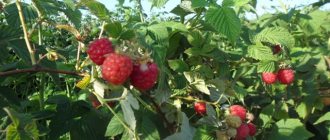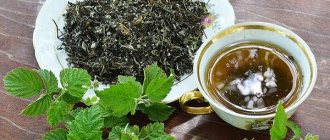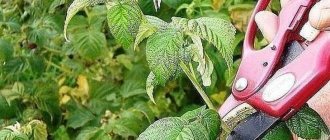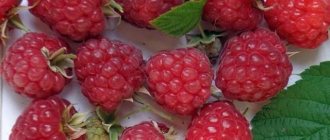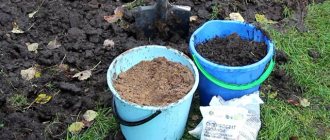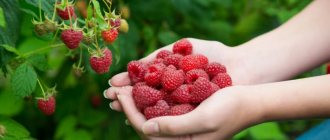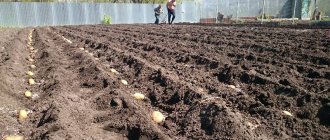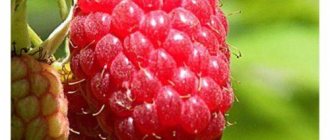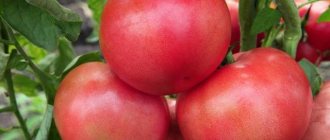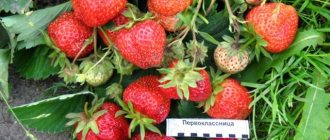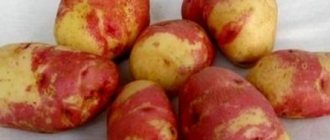The author of the Balsam variety, I.V. Kazakov, called it the best among the early ones - unpretentious, productive and resistant to adverse weather conditions, diseases and pests. For home gardening, the predictability of the behavior of a berry bush is an important advantage of the variety. For more than 30 years, Balsam has been pleasing summer residents with its berries, which are so similar in taste to wild raspberries - with sourness and a pronounced aroma.
Description of the variety
8-800-35-08-473 - free hotline for legal assistance on land law issues: dacha amnesty, registration of property rights (purchase and sale, inheritance, mortgage), settlement of disputes with neighbors, change of land category
Non-repairing Balsam does not belong to industrial varieties - the yield does not exceed 3.0 kg/m2 or 2.2 kg. from the bush. Summer residents fell in love with raspberries from a 2-year growing cycle primarily due to the friendly yield of large berries of a dark crimson color with a pronounced similarity of taste and aroma to wild ones.
You might be interested! Description of the most popular variety of 2016 - Caramel raspberry.
Main varietal features:
- A powerful bush with erect shoots up to 1.8 m in height pleases with a small number of thorns.
- The large, dark green leaves are distinguished by small, soft, light purple spines along the main veins on the underside of the leaf blade.
- An average amount of root shoots is formed.
- Ruby-scarlet berries without shine, elongated shape, have a dense consistency, adhere well to the stalk and do not crumble after ripening. Berry weight – up to 3.0 g.
- The first berries ripen at the end of June (Central region), the main yield of the bush is in early July.
Content of nutrients in berries:
- sugar 9.3%;
- dry matter 10%;
- vitamin C 25.5 mg/100 g;
- acidity 1.0%.
The ratio of sour and sweet is well balanced, the harmonious combination of taste with a bright raspberry aroma primarily explains the popularity of the variety.
Photo of a bush
Photos and descriptions of the Balsam raspberry variety allow you to form an idea about the plant:
- A spreading bush with powerful and erect shoots about 2 m high. There are few thorns and they are quite short. On shoots up to 1 year old, the thorns have a waxy coating, while on two-year-old bushes they become brown.
- The leaves are medium or large, bright green, wrinkled. The top of the leaf is matte, the bottom is whitish with a edge.
- The average number of shoots replacing root shoots is no more than 20 pcs. per 1 sq. m. This indicator is considered optimal for the propagation of shrubs, while the area will not quickly become overgrown.
- The fruits are dark, oblong, with a dense structure.
After reading the reviews of Russian summer residents, we can conclude that this variety is popular with most raspberry lovers.
A brief description of. Advantages and disadvantages
Gardeners have been growing Balsam raspberries for more than 30 years and have no intention of consigning them to the archives. The variety does not lose its attractiveness and is still popular.
Advantages of the variety
- unpretentiousness and resistance to traditional diseases of berry crops and most pests;
- dense berries do not wrinkle and can easily be transported;
- the shoots are powerful - it is not necessary to tie them to a trellis;
- weak thorniness of the stems does not create problems during harvesting;
- friendly yield of the harvest, the berries do not fall off during the ripening process;
- root shoots are formed in moderate quantities - raspberries do not “spread”;
- Not only do the berries resemble forest berries in taste, but the content of vitamin C and natural aspirin in the fruits is not inferior to their forest counterpart;
- The excellent winter hardiness of the variety allows the bushes to winter without shelter even in regions with little snow.
If you try, you can also find disadvantages - not too high yield and the sour taste of the berries. The advantage is clearly in favor.
History of raspberry balm
The author of Raspberry Balm is Ivan Vasilyevich Kazakov. This is a famous scientist, fruit grower, candidate of agricultural sciences, academician of the Russian Academy of Agricultural Sciences. Since 1963, the teaching and scientific activities of the outstanding breeder have been associated with the Kokinsky stronghold of the All-Russian Institute of Horticulture and Fruit Growing in the Bryansk region. It was there that Kazakov and his team created new varieties of raspberries, which, by the way, became the basis of the assortment for the European part of the Russian Federation. Among them are the first in the country suitable for machine picking of berries. The balm is included in this group.
Video: I. V. Kazakov confesses his love to a capricious lady - raspberry
By its origin, Balsam is a hybrid, since it was obtained as a result of cross-pollination of two different varieties: Bulgarian Ruby and Newburg. The new raspberry entered state variety testing in 1982 and only 11 years later was included in the State Register of Breeding Achievements. The admission region, that is, the territory in which Balsam is able to show its best side, has become almost all of Russia, except for the Urals, the Far East and the North.
Balsam is a classic raspberry, characterized by consistently high yields
Balsam has been grown in amateur gardens for more than 30 years. Due to its high commercial qualities, the berry sells well on the market. This raspberry is universal in its purpose. It has that same raspberry taste with a delicate forest aroma.
Landing
To get a good harvest of berries, you should choose the right site for growing raspberries, which must meet the following requirements:
- A sunny area on a hill or on a slight slope is best suited.
- On damp, heavy soils, it is preferable to grow raspberries on high ridges - it is enough to raise the level by 15-20 cm and the negative impact of excess moisture will be overcome.
- The site for the variety is prepared in the fall - deep digging and fertilizing the soil. A feature declared by the breeders is that Balsam prefers spring planting.
- It is preferable to plant seedlings in rows in the direction from north to south for maximum illumination of the plants. The distance between rows is up to 2 m, in a row – 0.7...0.8 m.
You might be interested! Description of a mid-season raspberry variety, specially bred for the North-Western region - raspberry Kirzhach.
To obtain stable yields, it is necessary not only to replace fallen bushes, but also to change the location of the raspberry tree every 10 years.
Features of care and maintenance
Raspberries should be provided with regular watering.
It’s no secret to anyone that the better the care of a plant during its development and growth, the greater the harvest you can get. In order for the raspberry balsam harvest to please the gardener, it is necessary:
- Once a week it is necessary to loosen the soil. This will allow the plant to develop, and the roots will receive air.
- Regular watering will ensure that moisture reaches the roots. It’s just important not to overdo it, otherwise the roots will begin to rot. Also, do not forget about fertilizing; for this purpose, it is recommended to water the raspberries with fertilizers once every two weeks.
- Pruning shoots. This is a very important point because if this manipulation is not carried out, the percentage of yield will decrease significantly. Pruning is carried out using a double method. The first year, the tops, which have grown by more than one meter, are pinched off. An important point is to do this at the end of May or early June. The next year, during the second pruning, side shoots are removed by about 10–15 centimeters. Also, starting from the first month of summer, it is necessary to clear away excess growth with a sharp shovel.
We use supports
To prevent raspberries from tilting as they grow, you need to use a support.
When the berries are fully ripened, the branches of the bush tilt the plant downwards, so experienced gardeners recommend using supports for growing. You can do this in 3 ways:
- An iron stake is driven into the center of the bush, to which the shoots are tied. The method, although effective, has one significant drawback, namely poor exposure to sunlight, which will lead to low yields.
- Iron supports are driven between the bushes and the wire is stretched. Some of the shoots are attached to one support, and the rest to another.
- Trellis method. Its essence lies in the fact that the stems are attached to the supports in early spring, before the buds have yet appeared.
Pest Control
The most dangerous and common pest is the raspberry beetle . It interferes with the normal development of berries.
The raspberry beetle is dangerous for the raspberry bush.
To combat it, it will be enough to simply shake it off the bush onto a film or use purchased products. stem gall midge and florist weevil can also cause harm . To prevent this from happening, you need to treat the soil with a special 1% solution of Bordeaux mixture in the fall.
Growing and care
Even the unpretentious varieties of breeder Kazakov require care. Compliance with the rules of agricultural technology will increase the yield and allow the bushes to enter the winter period stronger.
Watering
The raspberry bush experiences an increased need for water in 2 cases:
- during the period of intensive growth of green mass in spring, the plant uses the reserve of soil winter moisture;
- during the period of setting and filling berries.
During crop formation, in case of insufficient rainfall, raspberry bushes require watering. For watering to be useful, the water must wet the soil layers to a depth of 30...40 cm - it is at this level that the raspberry root system is located.
Trimming
Pruning bushes is intended for the correct formation of fruit-bearing shoots.
The general concept of “pruning” has a broad semantic content:
- pinching a shoot at a height of 80...90 cm in early May causes the growth of 2nd order branches;
- rationing – removal of excess thickening growth (nettle) and weak branches;
- removal of fruit-bearing shoots.
When thinning out the planting of raspberries, you should be guided by the general rule - leave no more than 10 shoots per 1 m2.
Feeding
Properly prepared soil for planting raspberries guarantees high berry yields for 3-4 years. It should be remembered that an excess of fertilizers for a plant is much worse than a lack of nutrients.
In autumn, when preparing the soil, the soil is filled with compost or humus at the rate of:
- 1/2 bucket of compost or humus per bush or 1 bucket per linear meter;
- mineral components, calcium, potassium and phosphorus, the soil is enriched in accordance with the instructions for the specific mineral complex, wood ash is added at the rate of 1 cup per bush or 1/2 liter per 1 linear meter.
To ensure that nutrition is supplied evenly throughout the growing season, the surface of the soil along the raspberry bushes is mulched with humus. The crumbly layer of organic matter should be at least 5...8 cm.
In the absence of organic matter, nitrogen additives are added with solutions of urea or saltpeter at the rate of 2 tbsp. spoons per 10 l. water per 1 linear meter.
Preparing for winter
Preparation for winter begins in mid-summer - immediately after the berries are released, the fruit-bearing branches are cut out flush with the ground. The biggest mistake inexperienced gardeners make is feeding young shoots with nitrogen fertilizers. The bushes will begin to grow, but the young wood will not have time to ripen. To increase winter hardiness, it is advisable to give the bushes compounds of potassium, phosphorus and other microelements, which are so abundant in wood ash. It is quite enough to give 0.5 liters per 1 m2 of planting. a jar of ash - scatter evenly and loosen the soil a little.
Many years of practice have shown that in the conditions of the Moscow region and the Leningrad region, Balsam survives the winter well without additional shelter for the winter. In conditions of little snow and harsh winters in the Central region, the Urals and Siberia, it is better to bend raspberry bushes to the ground for a successful and safe wintering.
Care
Caring for raspberry balm should be comprehensive. In order to get a good harvest, you need to master several rules:
Loosening the soil
Ideally, loosening the soil is done once a week. In this case, the earth will always be soft and the raspberries will be able to grow and develop, the roots will “breathe” freely.
Watering
You need to water the berries quite often, but avoid excessively damp soil, which can lead to rotting of the roots. It is recommended to water the raspberries with organic fertilizers approximately once every two weeks.
Pruning shoots
In order for raspberries to produce a rich harvest every year, it is recommended to trim the shoots using the Sobolev method (double pruning). To do this, in the first year at the beginning of summer, all raspberry shoots are shortened by 10-15 cm, and a year later all lateral growths are cut by 10-15 cm.
This is done to stimulate their branching.
It is important to carry out the work in a timely manner, preferably at the end of May, but the first week of June is also acceptable. The next year, also in the spring, a second side pruning is done.
More on the topic: Raspberry variety Antares
Immediately after the end of raspberry fruiting, it is necessary to cut out all fruit-bearing shoots (two-year-old shoots covered with bark). These branches are taken away and burned so as not to provoke the spread of infections.
In late autumn, remove all excess shoots, diseased and dry branches.
From the beginning of summer it is necessary to remove the shoots from Balsam. This is done periodically using a sharp shovel.
They also don’t forget about rationing, cutting out the weakest or smallest shoots in the row so that there are no more than a dozen of them left per linear meter.
In the spring, raspberry shoots are inspected and branches that have rotted and rotted over the winter are removed.
Garter
The thickness of Balsam's shoots is sufficient, but a bountiful harvest of berries is quite capable of putting the stems on the ground, which will have a bad effect on the quality of the fruit and their integrity. Therefore, the raspberry tree will have to be tied up. There are several suitable ways:
- A wooden stake is driven into the center of each raspberry bush, to which all the shoots are tied.
- Fan fastening of raspberries involves the use of a pair of supports and a wire stretched between them. Then half of the bush is directed in one direction, and the second part of the raspberry is directed towards the opposite support.
- With the trellis method, raspberries are tied up in early spring, when the shoots are just starting to grow. The wire is stretched in three tiers (at a height of 60, 120 and 160 cm).
It is the trellis garter that is most suitable for Balsam bushes. This way the shoots are better ventilated and the raspberries receive enough light.
Top dressing
It is clear that without additional fertilization of the land there will be no good raspberry harvests, no matter how prolific the variety is. There should be several feedings per season:
- In early spring, when the buds begin to grow, the soil under the raspberries is fed with fertilizers containing nitrogen (nitroammophosphate, ammonium nitrate, urea).
- When buds appear on the Balsam bushes (but have not yet blossomed), the raspberries need to be fed with a mineral complex, in which potassium, calcium, phosphorus and iron predominate. At this stage, a lot of nitrogen is not required. It is better to use potassium preparations, superphosphate, and wood ash.
- At the fruiting stage of raspberries, it is recommended to use liquid mullein or bird droppings diluted in water - the bushes are watered with this mixture.
In the fall, when the Balsam raspberries have already been pruned, you can scatter humus, compost or peat around the area, and scatter ash.
More on the topic: One of the best European varieties - Enrosadir raspberries
Reproduction
Raspberry Balsam has a characteristic feature that should not be forgotten: the variety shows its best qualities when planting seedlings in spring.
The area for raspberries must be prepared in advance, in the fall:
- dig deep and select the roots of perennial weeds;
- mark the rows and fill the planting trenches with nutrients - 4-5 kg each. humus and 0.5 l. ash per linear meter of row.
It is better to plant with the expectation of growing on a trellis to avoid damage to the bush.
Planting is carried out with seedlings shortened to 30...40 cm in height. Shorten the shoot immediately before planting. Plants are planted without burial. After planting, water and mulch with humus or compost, the layer should be at least 5...8 cm.
Landing Features
If you want to collect large and sweet berries, then select a sunny place for the raspberry tree. And this is not always located under the fence, where summer residents usually like to plant raspberries. If the soil is heavy and clayey, then first dig up the entire plot allocated for the berry garden, adding loosening materials: peat, compost, hay dust, last year’s leaves, small twigs, etc. Sandy soil can be corrected with the same materials.
It is better not to use sand as a loosening agent, since although they are crushed stones, they do not improve the soil in any way and make it loose, to the detriment of moisture capacity. Sandy soils do not retain moisture and nutrients at the roots of plants; they pass through them into the lower layers, which leads to chlorosis of the leaves, poor development and fruiting in general.
On loamy and sandy loam soils, it is enough to apply fertilizer. Depending on the season of preparation of the site, before digging, scatter 1 m²:
- in autumn - 1.5 buckets of humus, 30 g of superphosphate and 20 g of potassium sulfate;
- in spring - 1.5 buckets of humus, 0.5 liters of wood ash.
When placing Balsam on a prepared bed, take into account its ability to grow tall and spreading bushes. The distance in the row between seedlings is at least 0.7–1.0 m. Leave the row spacing so that it is convenient for you to walk on them and pick berries, but not less than 2 m. Powerful bushes should be well lit and ventilated.
Wide row spacing provides good illumination of the bushes and comfort when caring for raspberries and harvesting
The procedure for planting seedlings is as follows:
- on the dug up and fertilized area according to the scheme (minimum 0.7x2 m), make holes corresponding to the size of the roots of the seedlings;
- fill them with water heated in the sun and wait until it is absorbed;
- place the seedlings in the holes, straighten the roots and cover with soil;
- mulch the plantings.
Plant raspberries at the same depth at which they grew before, without deepening the root collar.
Recent Entries
5 working ways to use tar in the garden 7 indoor plants that help you get married even in adulthood Indoor plants that can bloom in trouble
Video: planting raspberries
Reviews
I simply couldn’t help but write a review about the Balm, because... the variety, one might say, proved to be a balm on my soul. I spent my entire childhood in the village and really loved wild raspberries, so after moving to the city and having a garden plot, I dreamed of growing a variety that was closest to the forest variety. You read reviews from gardeners and basically everyone describes the size of the berries or the overall yield, so I didn’t find my Balm right away. A neighbor in a gardening partnership helped, who once complained that there seemed to be no forest nearby, but wild raspberries had moved to her from somewhere. I clung to this information and that’s how raspberries appeared on my plot, which I have been growing for almost 10 years. I really like the variety precisely for its taste and aroma from childhood; in addition, it is early, practically without thorns and winter-hardy. It seems to me that this is just an excellent combination of the most important qualities of a berry crop.
Everything is fine. I’ve been growing “Balsam” for five years. I live in difficult conditions for raspberries in Siberia, but at the same time I manage to feast on delicious berries, the bushes do not freeze and are generally very unpretentious. I don’t water or feed the raspberries, I just trim them, but they bear fruit and don’t get smaller.
Growing the Balsam variety is not difficult - breeders took care of this back in the distant 80s of the last century. Unpretentious and hardy bushes are not afraid of frost and thaw; they awaken early in the spring and are ready to produce a harvest of fragrant berries at the end of June.
